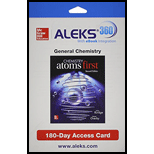
(a)
Interpretation:
The molecular mass/formula mass of the given substances has to be calculated.
Concept introduction:
The sum of the
(a)
Answer to Problem 5.68QP
Molecular mass of
Explanation of Solution
To calculate: Molecular mass of
Molecular formula is given as
(b)
Interpretation:
The molecular mass/formula mass of the given substances has to be calculated.
Concept introduction:
The sum of the atomic masses of all the atoms present in that molecule will give an overall mass of that molecule which is termed as Molecular mass. The sum of the atomic masses of individual atoms present in a formula unit will be termed as formula mass, it may or may not be a formula of molecule.
(b)
Answer to Problem 5.68QP
Molecular mass of
Explanation of Solution
To calculate: Molecular mass of
Molecular formula is given as
The molecular mass of the given substance was calculated using atomic weights of each elements present in its molecular formula. The molecular mass of
(C)
Interpretation:
The molecular mass/formula mass of the given substances has to be calculated.
Concept introduction:
The sum of the atomic masses of all the atoms present in that molecule will give an overall mass of that molecule which is termed as Molecular mass. The sum of the atomic masses of individual atoms present in a formula unit will be termed as formula mass, it may or may not be a formula of molecule.
(C)
Answer to Problem 5.68QP
Molecular mass of
Explanation of Solution
To calculate: Molecular mass of
Molecular formula is given as
The molecular mass of the given substance was calculated using atomic weights of each elements present in its molecular formula. The molecular mass of
(d)
Interpretation:
The molecular mass/formula mass of the given substances has to be calculated.
Concept introduction:
The sum of the atomic masses of all the atoms present in that molecule will give an overall mass of that molecule which is termed as Molecular mass. The sum of the atomic masses of individual atoms present in a formula unit will be termed as formula mass, it may or may not be a formula of molecule.
(d)
Answer to Problem 5.68QP
Formula mass of
Explanation of Solution
To calculate: Formula mass of
Molecular formula is given as
The formula mass of the given substance was calculated using atomic weights of each elements present in its formula unit. The molecular mass of
(e)
Interpretation:
The molecular mass/formula mass of the given substances has to be calculated.
Concept introduction:
The sum of the atomic masses of all the atoms present in that molecule will give an overall mass of that molecule which is termed as Molecular mass. The sum of the atomic masses of individual atoms present in a formula unit will be termed as formula mass, it may or may not be a formula of molecule.
(e)
Answer to Problem 5.68QP
Formula mass of
Explanation of Solution
To calculate: Formula mass of
Molecular formula is given as
The formula mass of the given substance was calculated using atomic weights of each elements present in its formula unit. The molecular mass of
(f)
Interpretation:
The molecular mass/formula mass of the given substances has to be calculated.
Concept introduction:
The sum of the atomic masses of all the atoms present in that molecule will give an overall mass of that molecule which is termed as Molecular mass. The sum of the atomic masses of individual atoms present in a formula unit will be termed as formula mass, it may or may not be a formula of molecule.
(f)
Answer to Problem 5.68QP
Molecular mass of
To calculate: Molecular mass of
Molecular formula is given as
Explanation of Solution
The molecular mass of the given substance was calculated using atomic weights of each elements present in its molecular formula. The molecular mass of
(g)
Interpretation:
The molecular mass/formula mass of the given substances has to be calculated.
Concept introduction:
The sum of the atomic masses of all the atoms present in that molecule will give an overall mass of that molecule which is termed as Molecular mass. The sum of the atomic masses of individual atoms present in a formula unit will be termed as formula mass, it may or may not be a formula of molecule.
(g)
Answer to Problem 5.68QP
Molecular mass of
Explanation of Solution
To calculate: Molecular mass of
Molecular formula is given as
The molecular mass of the given substance was calculated using atomic weights of each elements present in its molecular formula. The molecular mass of
Want to see more full solutions like this?
Chapter 5 Solutions
Aleks 360 Access Card (1 Semester) For Chemistry: Atoms First
 ChemistryChemistryISBN:9781305957404Author:Steven S. Zumdahl, Susan A. Zumdahl, Donald J. DeCostePublisher:Cengage Learning
ChemistryChemistryISBN:9781305957404Author:Steven S. Zumdahl, Susan A. Zumdahl, Donald J. DeCostePublisher:Cengage Learning ChemistryChemistryISBN:9781259911156Author:Raymond Chang Dr., Jason Overby ProfessorPublisher:McGraw-Hill Education
ChemistryChemistryISBN:9781259911156Author:Raymond Chang Dr., Jason Overby ProfessorPublisher:McGraw-Hill Education Principles of Instrumental AnalysisChemistryISBN:9781305577213Author:Douglas A. Skoog, F. James Holler, Stanley R. CrouchPublisher:Cengage Learning
Principles of Instrumental AnalysisChemistryISBN:9781305577213Author:Douglas A. Skoog, F. James Holler, Stanley R. CrouchPublisher:Cengage Learning Organic ChemistryChemistryISBN:9780078021558Author:Janice Gorzynski Smith Dr.Publisher:McGraw-Hill Education
Organic ChemistryChemistryISBN:9780078021558Author:Janice Gorzynski Smith Dr.Publisher:McGraw-Hill Education Chemistry: Principles and ReactionsChemistryISBN:9781305079373Author:William L. Masterton, Cecile N. HurleyPublisher:Cengage Learning
Chemistry: Principles and ReactionsChemistryISBN:9781305079373Author:William L. Masterton, Cecile N. HurleyPublisher:Cengage Learning Elementary Principles of Chemical Processes, Bind...ChemistryISBN:9781118431221Author:Richard M. Felder, Ronald W. Rousseau, Lisa G. BullardPublisher:WILEY
Elementary Principles of Chemical Processes, Bind...ChemistryISBN:9781118431221Author:Richard M. Felder, Ronald W. Rousseau, Lisa G. BullardPublisher:WILEY





